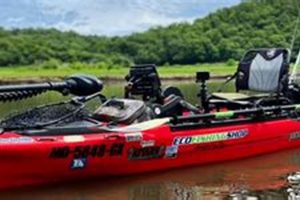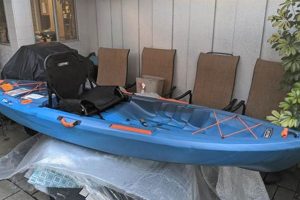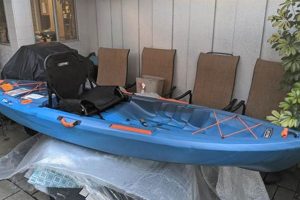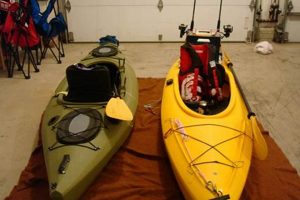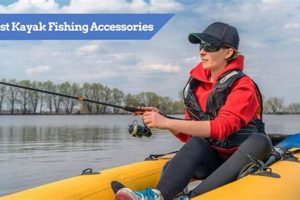Essential gear for kayak anglers often includes items designed for comfort, safety, and enhanced fishing success. Examples include rod holders, fish finders, and specialized storage solutions tailored to the kayak fishing environment.
Appropriate equipment significantly improves the kayak fishing experience. It enables anglers to focus on the sport while ensuring safety and efficiency on the water. Historically, kayak fishing relied on simpler adaptations of general fishing gear. Modern innovations, however, have led to purpose-built accessories that optimize both performance and enjoyment. This evolution has made the activity more accessible and appealing to a wider range of anglers.
This article will examine various important categories of equipment for kayak anglers, delving into specific product recommendations and selection criteria. It will cover key features, benefits, and considerations for choosing the right gear to maximize one’s time on the water.
Essential Kayak Fishing Equipment Tips
Optimizing a kayak for fishing requires careful selection of accessories. These tips offer guidance on choosing appropriate equipment to enhance safety, comfort, and fishing success.
Tip 1: Prioritize Stability: Kayak stability is paramount. Wider kayaks offer more stability, especially for anglers standing to cast. Outriggers can further enhance stability for smaller kayaks.
Tip 2: Choose Appropriate Rod Holders: Rod holders should secure rods effectively while allowing easy access for casting and retrieving. Flush-mount and adjustable rod holders provide flexibility for different fishing techniques.
Tip 3: Invest in a Quality Fish Finder: Fish finders greatly improve the odds of locating fish. Consider models with GPS and mapping capabilities for navigating unfamiliar waters and marking productive fishing spots.
Tip 4: Maximize Storage Solutions: Kayaks offer limited space. Dry bags, tackle boxes designed for kayaks, and crate systems optimize storage and keep gear organized and protected from water.
Tip 5: Ensure Personal Safety: A personal flotation device (PFD) is essential. A whistle, signaling mirror, and communication device are also crucial for safety, especially in remote locations.
Tip 6: Consider an Anchor Trolley System: An anchor trolley system allows for controlled anchoring and positioning of the kayak in various current and wind conditions, maximizing fishing efficiency.
Tip 7: Select a Comfortable Paddle: An appropriately sized and lightweight paddle reduces fatigue during long paddling sessions, allowing anglers to cover more water and fish comfortably.
Careful consideration of these factors ensures a more productive and enjoyable kayak fishing experience. Appropriate equipment selection enhances safety and allows anglers to focus on the sport itself.
By implementing these recommendations, anglers can create a personalized and effective kayak fishing setup tailored to their specific needs and preferences. The following section will conclude the discussion with final recommendations and key takeaways.
1. Rod Holders
Rod holders are integral to the “top 10 fishing kayak accessories” list due to their direct impact on fishing efficiency and safety. Without secure rod storage, anglers face challenges in managing multiple rods, increasing the risk of tangling lines, losing rods overboard, or interfering with paddling. Dedicated rod holders free an angler’s hands for paddling, landing fish, and other essential tasks. For example, an angler trolling with multiple lines requires rod holders to maintain proper line spread and depth, maximizing the chances of a catch. Similarly, when fighting a fish, having other rods securely stored prevents interference and potential breakage.
Various rod holder designs exist, each offering specific benefits. Flush-mounted rod holders maintain a low profile, minimizing interference with paddling and casting. Adjustable rod holders allow anglers to customize rod angles for different fishing techniques. Specialty rod holders cater to specific fishing styles, such as fly fishing or trolling. The choice of rod holder depends on the type of fishing pursued, the kayak’s layout, and individual angler preferences. Investing in high-quality rod holders ensures durability and secure rod placement, even in rough conditions. This contributes significantly to a more organized and productive fishing experience.
Selecting appropriate rod holders demonstrates a clear understanding of kayak fishing essentials. This seemingly small detail greatly enhances the overall experience by improving efficiency, safety, and enjoyment on the water. Failure to prioritize rod holders compromises an angler’s ability to manage equipment effectively, potentially leading to frustration and lost fishing opportunities. Therefore, rod holders are a critical component of the “top 10 fishing kayak accessories,” playing a fundamental role in optimizing the kayak fishing setup.
2. Fish Finder
A fish finder earns its place among the top 10 fishing kayak accessories due to its capacity to significantly improve angling success. Locating fish quickly and efficiently is paramount in kayak fishing, where mobility is key. A fish finder provides real-time underwater insights, eliminating guesswork and allowing anglers to focus efforts on promising areas.
- Locating Fish and Structure:
Fish finders utilize sonar technology to identify fish and underwater structures like reefs, drop-offs, and vegetation. This information is crucial for targeting specific species and understanding fish behavior. For example, locating a school of baitfish near a submerged structure suggests a high probability of finding predator fish in the vicinity. This allows anglers to strategically position their kayaks and select appropriate lures or bait.
- Determining Depth and Water Temperature:
Knowing the water depth and temperature is essential for selecting appropriate fishing techniques and targeting specific species. A fish finder provides accurate depth readings, enabling anglers to adjust lure depth and presentation. Water temperature data helps determine fish activity levels and preferred locations. For instance, certain fish species prefer cooler, deeper waters during warmer months, information readily available through a fish finder.
- GPS and Mapping Capabilities:
Many modern fish finders integrate GPS and mapping features. This allows anglers to mark productive fishing spots, navigate unfamiliar waters, and track their movements. Marking waypoints on a map simplifies returning to successful locations, while GPS navigation ensures safe and efficient travel, especially in challenging conditions or during low-visibility periods. This feature is invaluable for exploring new fishing grounds or returning to proven spots.
- Portability and Kayak Integration:
Fish finders designed for kayaks offer compact size and portability, integrating seamlessly with kayak setups. Battery-powered models provide convenient power solutions for kayak use. Transducer mounting options cater specifically to kayak hulls, ensuring accurate sonar readings without compromising kayak performance. This specialized design makes them invaluable tools for kayak anglers.
The combination of these features solidifies the fish finder’s position as a core element within the top 10 fishing kayak accessories. By providing crucial underwater intelligence, navigation assistance, and seamless integration with kayak systems, a fish finder empowers anglers to make informed decisions, maximize their time on the water, and ultimately enhance their fishing success. Investing in a quality fish finder represents a significant step toward a more productive and enjoyable kayak fishing experience.
3. Paddle/PFD
Paddle/PFD combinations represent fundamental safety and performance components within the top 10 fishing kayak accessories. A paddle facilitates propulsion and maneuverability, while a PFD (Personal Flotation Device) ensures safety in the event of capsizing or emergencies. These two items are inseparable in their contribution to a safe and effective kayak fishing experience. Neglecting either aspect compromises both safety and the ability to effectively fish from a kayak.
- Paddle Selection and Performance:
Paddle choice directly impacts paddling efficiency and fatigue levels. Lightweight, appropriately sized paddles minimize exertion, allowing for longer paddling sessions and covering greater distances. Blade shape and material influence paddling style and performance in various water conditions. A paddle suited to an individual’s physique and paddling style enhances efficiency and reduces strain, maximizing time spent fishing rather than battling fatigue.
- PFD Importance and Types:
PFDs are non-negotiable safety equipment. Different PFD types cater to specific activities and comfort levels. Inflatable PFDs offer greater freedom of movement, while inherently buoyant PFDs provide continuous flotation. Choosing a comfortable, properly fitted PFD ensures it will be worn consistently, maximizing safety without hindering movement while casting or reeling.
- Combined Impact on Fishing Experience:
The synergy between paddle and PFD directly affects the overall fishing experience. A comfortable and efficient paddle, coupled with a well-fitting PFD, allows anglers to focus on fishing without discomfort or safety concerns. This combination contributes to longer, more productive fishing trips by maximizing mobility and ensuring safety on the water.
- Essential Safety Considerations:
Paddle and PFD selection underscores a commitment to safe kayaking practices. Regular PFD inspection and proper paddle maintenance ensure reliable performance in critical situations. Understanding basic paddling techniques and self-rescue procedures further enhances safety, allowing anglers to confidently navigate various water conditions and respond effectively to emergencies.
The inclusion of both paddle and PFD in the top 10 fishing kayak accessories highlights their crucial roles. These items are not mere additions but essential components of responsible and productive kayak fishing. Prioritizing paddle selection and PFD fit demonstrates a commitment to safety and performance, ultimately maximizing enjoyment and success on the water. A proper paddle/PFD combination provides the foundation for a safe and productive day of fishing, ensuring anglers can fully focus on their sport while minimizing fatigue and maximizing safety.
4. Anchor Trolley
An anchor trolley system secures its position within the top 10 fishing kayak accessories due to its significant contribution to controlled positioning and enhanced fishing effectiveness. Unlike fixed anchor points, an anchor trolley allows anglers to adjust anchor position along the length of the kayak, optimizing boat orientation relative to current, wind, and structure. This adaptability is crucial for maintaining desired fishing locations and presentations, particularly in dynamic environments. For example, when fishing a river channel, an angler can use the trolley to position the kayak broadside to the current, allowing a natural drift and consistent bait presentation. Alternatively, when fishing near a shoreline structure, the trolley enables positioning the kayak parallel to the structure, maximizing casting angles and minimizing snag potential.
Practical applications of an anchor trolley system extend beyond basic positioning. In windy conditions, the trolley allows adjustment of the anchor point to minimize wind drift and maintain a stable fishing platform. This is particularly valuable in open water or when fishing near structure where precise boat control is essential. Furthermore, the trolley system facilitates techniques like controlled drifting, allowing anglers to cover water methodically while maintaining a desired depth or proximity to structure. This adaptability transforms the kayak into a more versatile and effective fishing platform, maximizing opportunities for success in diverse conditions. Without an anchor trolley, anglers are limited to fixed anchor points, sacrificing control and adaptability in dynamic environments.
Effective deployment of an anchor trolley system requires understanding its components and functionality. The system typically consists of a side-mounted track or rope, rings, and carabiners, allowing for adjustable anchor attachment. Proper installation and adjustment ensure smooth operation and reliable performance. Challenges may include line tangling or trolley slippage, often mitigated through proper rigging and hardware selection. Understanding these potential challenges and implementing preventative measures ensures the trolley system contributes effectively to a more controlled and productive kayak fishing experience, solidifying its position as a key accessory within the top 10. The ability to precisely control kayak position directly impacts fishing success, making the anchor trolley a crucial tool for serious kayak anglers.
5. Dry Storage
Dry storage earns its place among the top 10 fishing kayak accessories due to the critical need to protect essential gear from water damage. Kayaks, by their nature, operate in a wet environment. Electronics, clothing, food, and other vital items require protection from splashes, rain, and even accidental submersion. Dry storage solutions, such as dry bags, waterproof cases, and specialized kayak hatches, provide this essential protection. Consider a fishing trip where unexpected rain soaks the kayak. Without dry storage, essential items like a cell phone, first-aid kit, or extra layers of clothing become unusable, potentially jeopardizing safety and comfort. Conversely, with properly utilized dry storage, these items remain protected and functional, ensuring a continued safe and enjoyable experience regardless of weather conditions.
Practical applications of dry storage extend beyond basic protection from the elements. Organized dry storage solutions contribute significantly to efficient gear management within the limited space of a kayak. Dedicated compartments for tackle, tools, and personal items reduce clutter and allow for quick access to necessary equipment. For example, a well-organized tackle box within a dry storage compartment allows anglers to quickly change lures or rigs without rummaging through a wet and disorganized storage area. This efficiency maximizes fishing time and minimizes frustration. Furthermore, dry storage contributes to kayak stability by distributing weight evenly and preventing loose items from shifting during paddling or maneuvering. This stability is crucial for maintaining balance and control, particularly in challenging conditions or when standing to cast.
Effective dry storage implementation requires careful consideration of storage needs and available kayak space. Different dry storage solutions offer varying levels of protection and capacity. Dry bags provide versatile and portable storage for clothing and electronics. Hard-shell cases offer robust protection for sensitive equipment like cameras or GPS devices. Built-in kayak hatches provide integrated storage solutions for larger items. Selecting appropriate dry storage solutions based on individual needs and kayak configuration maximizes protection and organization. Understanding the limitations of different dry storage solutions, such as the potential for punctures in dry bags or the limited capacity of hard-shell cases, allows for informed decisions and proactive measures to mitigate potential issues. Ultimately, effective dry storage contributes significantly to a safe, organized, and enjoyable kayak fishing experience, validating its inclusion within the top 10 essential accessories.
Frequently Asked Questions about Essential Kayak Fishing Accessories
This section addresses common inquiries regarding the selection and utilization of essential kayak fishing accessories. Clear understanding of these aspects contributes to informed decisions and enhanced on-the-water experiences.
Question 1: How does one choose appropriate rod holders for a fishing kayak?
Rod holder selection depends on fishing style, kayak layout, and desired rod angles. Flush-mount holders maintain a low profile, while adjustable holders offer versatility. Specialty holders cater to specific techniques like trolling or fly fishing. Compatibility with the kayak’s gunwales or rails is crucial.
Question 2: What features should one consider when selecting a fish finder for kayak fishing?
Key features include sonar clarity, GPS and mapping capabilities, portability, and kayak-specific mounting options. Screen size, battery life, and transducer type influence usability and performance. Compatibility with existing kayak electronics is a practical consideration.
Question 3: What type of PFD is recommended for kayak fishing?
Inherently buoyant PFDs offer continuous flotation, while inflatable PFDs provide greater freedom of movement. Comfort, proper fit, and adherence to local regulations are paramount. Anglers should choose a PFD approved for water sports and appropriate for the fishing environment.
Question 4: How does an anchor trolley system improve kayak fishing?
Anchor trolleys enhance boat control by allowing adjustable anchor positioning. This enables precise positioning relative to current, wind, and structure. Controlled drifting and maintaining optimal fishing angles become significantly easier with an anchor trolley system.
Question 5: What are the essential considerations for choosing dry storage solutions for a kayak?
Storage capacity, item sensitivity to water, and available kayak space dictate dry storage choices. Dry bags, waterproof cases, and kayak hatches offer varying levels of protection and organization. Durability and ease of access are important factors for frequent use.
Question 6: How does one prioritize among the top 10 fishing kayak accessories when working with a limited budget?
Safety equipment like PFDs and essential paddling gear should take precedence. Rod holders and basic dry storage are fundamental for effective fishing. Fish finders and anchor trolleys can be added as budget allows, enhancing fishing efficiency and control over time.
Careful consideration of these factors ensures informed decisions when selecting and utilizing kayak fishing accessories. Prioritizing safety and functionality leads to a more productive and enjoyable experience on the water.
The next section will offer concluding remarks and summarize key takeaways regarding optimizing a kayak for fishing.
Optimizing Kayak Fishing Performance Through Essential Accessories
Careful selection of fishing kayak accessories significantly impacts on-the-water success. Prioritizing essential equipment categoriesrod holders, fish finders, paddles/PFDs, anchor trolleys, and dry storageenhances safety, efficiency, and overall fishing performance. Understanding the function and application of each accessory category empowers informed decisions tailored to individual fishing styles and kayak configurations. Appropriate equipment choices contribute to a more organized, productive, and enjoyable kayak fishing experience.
Strategic investment in essential kayak fishing accessories represents a commitment to maximizing potential on the water. Proper equipment selection transforms a kayak into a highly effective fishing platform, enabling anglers to focus on the sport with enhanced safety and efficiency. Continued exploration of available accessories and refinement of personal kayak setups unlock opportunities for improved performance and deeper appreciation of the sport.


